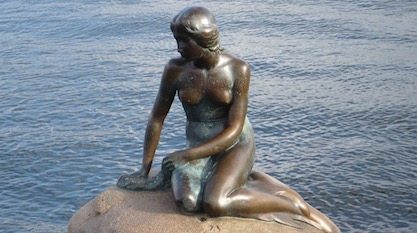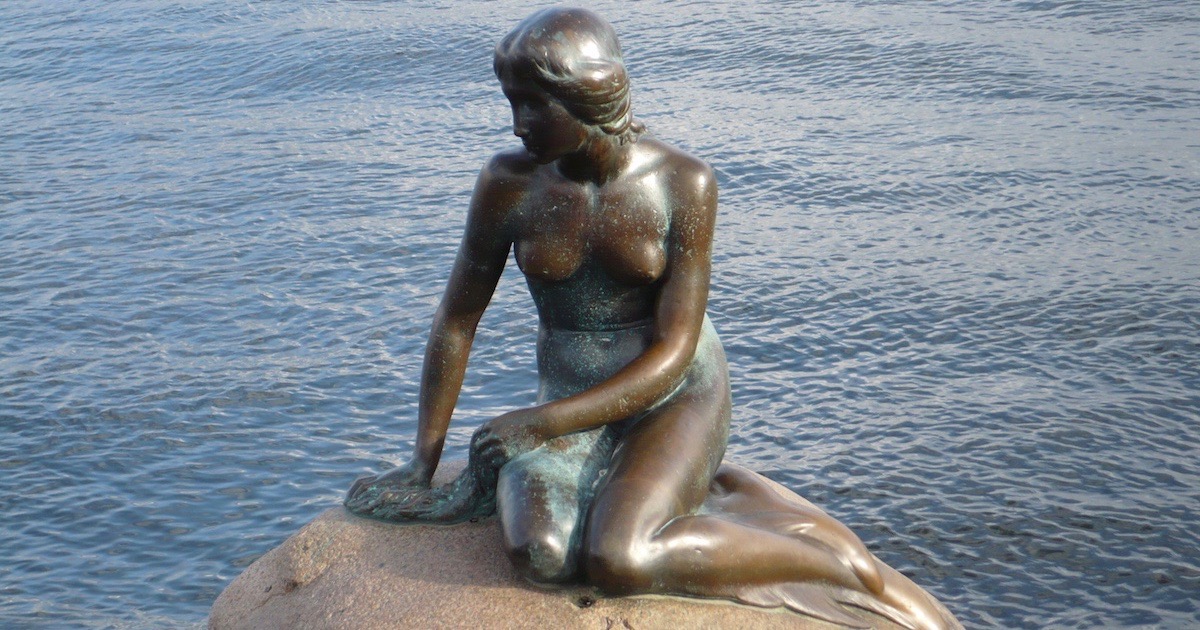 Evolution
Evolution
Humans Are Not Evolving into Mermaids


Darwinists assert that humans are undergoing natural selection, too. Therefore, evolution is a fact. Is the latest claim about “humans still evolving” all wet?
In a recent article on sea turtles, we weighed the evolutionary idea that “opportunity shapes adaptation.” We asked, “Well, if opportunities can shape adaptations, we should see human mermaids by now, shouldn’t we?” Almost immediately, news articles start appearing promoting the idea that some groups of people are indeed evolving into free-divers. For instance, Jan Hoole at The Conversation writes, “Are humans still evolving? Freediving people have evolved to stay underwater longer.” This deserves some scrutiny. Is it really natural selection in action? Hoole writes:
The deepest dive recorded by the free-diving Bajau Laut people of Southeast Asia was to an impressive 79 metres [260 feet], and the longest time spent underwater by them was just over three minutes. Although the Bajau do not dive to these depths or for this length of time during their day-to-day fishing, they spend up to 60% of their working life underwater.
New research published in the journal Cell shows that they have some physical and genetic adaptations to help them make these amazing dives. It seems that, although we tend to see ourselves as at the pinnacle of the natural world, evolution still has a grip on some groups of people. It is changing them to better suit their environment and their unusual lifestyle. [Emphasis added.]
The journal article speaks of “Physiological and Genetic Adaptations to Diving in Sea Nomads.” Legs turning into flippers could not be far behind! Here are some highlights of the study by Llardo et al.
- The Bajau, or “Sea Nomads,” have engaged in breath-hold diving for thousands of years.
- Selection has increased Bajau spleen size, providing an oxygen reservoir for diving.
- We find evidence of additional diving-related phenotypes under selection.
The story is reminiscent of the old “aquatic ape” hypothesis that enjoyed brief popularity among Darwinians in the 1980s. It was supposed to explain hairlessness and subcutaneous fat in humans, among other “adaptations” that make humans distinct from apes. One of its proponents’ books became a best seller in 1972. Most Darwinians now treat the “aquatic ape” notion with skepticism or silence, although a few holdouts remain. Daniel Dennett remarked in 1995 that “Both sides are indulging in adapt[at]ionist Just So stories.” Is history repeating itself in the current claim about freediving Sea Nomads?
One thing is clear; the media love the story. Paul Rincon at the BBC News writes, “Bajau people ‘evolved bigger spleens’ for free-diving,” calling this “a striking example of natural selection.” The evidence might seem convincing. Even non-diving people of the Bajau community have inherited spleens that are up to 50 percent larger on average than neighboring groups:
“We could ask the question: are there any genetic variants — are there any mutations — that are at a much higher frequency, that have changed their frequency specifically in the Bajau compared to other populations,” said co-author Prof Rasmus Nielsen, from the University of California, Berkeley.
The results of this “selection scan” turned up 25 sites in the genome that differed significantly in the Bajau compared to the other groups. Of these, one site on a gene known as PDE10A was found to correlate with the Bajau’s larger spleen size, even after accounting for confounding factors like age, sex, and height.
The journal Cell’s press release reproduced by Science Daily calls the increased spleen adaptation “a rare example of natural selection in modern humans.” We need to know what spleen size has to do with diving:
Spleen size is significant because of the organ’s role in the human dive response, which occurs when our faces are submerged in water and we hold our breath. As our heart rate slows and blood vessels in our extremities constrict, the spleen contracts, releasing oxygenated red blood cells and making more oxygen available in the bloodstream. A larger spleen means that more oxygen gets released.
Sarah Gibbens at National Geographic is a little less dogmatic in her subtitle, saying, “natural selection may have made them genetically stronger divers.” But the genetic link to spleen size seems to nail the case for natural selection, doesn’t it? Here is an adaptive trait with a genetic signature. Darwinism proved! Add to that, the researchers note that other mammals that dive often, like seals, have enlarged spleens. There are also known “adaptations” to high-altitude climbing in Tibetans and Nepalese, and for toleration of dietary fat in the Inuit people.
Analyzing the Natural Selection Claim
For neo-Darwinism to account for the observations, we would expect to find new genetic information from mutations. Llardo et al. only mention mutations once:
It is important to note that because the lead variants may not be the causal variants, this might affect our estimates and skew our conclusions toward selection from standing variation rather than from de novo mutation. As an additional check, we therefore examined the width of the likelihood ratio peaks for the lead SNP [single nucleotide polymorphism] in PDE10A and BDKRB2 by calculating the distance between the two most distant SNPs that define the sweep region. We found the peak widths to be extremely short (5,583 bp and 2,825 bp, respectively), providing additional evidence of a sweep from standing variation.
A standing variation already existed in the human gene pool, therefore; nothing new was created by mutation — just a modification in size to an existing organ. The quote means that the capacity for large spleens already existed in the population, fitting Doug Axe’s principle that selection cannot invent things. Besides, could anyone prove that a large spleen was not the original designed trait? If it was, then selection reduced the genetic information in non-divers. The authors think a “selective sweep” for the genetic variant occurred sometime before the Bajau population even began their diving lifestyle. Also, we would like to know if the SNP is random, or perhaps one of the mutational hotspots that can be turned on epigenetically according to environmental need. The authors did not establish whether the SNP is reversible.
The case also sounds weak in that only one of 25 candidate genes appears to have something to do with breath-holding ability (the other 24 candidate genes listed by Llardo et al. “remain promising targets for future studies”). And only 37 percent of the Bajau have the PDE10A variant, which has “broad geographic distribution” in other humans who are not free-divers. It’s not clear if any of the 63 percent without the variant were successful divers; one of the charts shows a wide range in Bajau spleen sizes. One successful diver without the variant, or with a smaller spleen, would falsify the hypothesis, but we don’t see them checking that point. Given all the caveats by the authors, how strong is this example? Does it warrant the confident claims in the Discussion section?
Overall, our results suggest that the Bajau have undergone unique adaptations associated with spleen size and the diving response, adding new examples to the list of remarkable genetic adaptations humans have experienced in recent evolutionary history. Similar to other of the most extreme adaptations human [sic] have experienced, such as adaptation to diet associated with pastoralism (Ranciaro et al., 2014) or shifts in environmental availability of food resources (Fumagalli et al., 2015), these genetic adaptations have emerged as a consequence of new cultural practices, illustrating that human culture and biology have been co-evolving for thousands of years.
Looking at the empirical observations without Darwin glasses on, one may infer that humans — like all other organisms on the planet — come equipped with the genetic toolkit to survive in a wide variety of environments. Some traits can be accentuated epigenetically by repeated exposure to certain environments, such as heat or cold, altitude, or the need to avoid hypoxia when diving, and then passed on to descendants. Some traits can be developed by training. The authors only suggested modest possibilities about genetic causation, leaving open other possibilities. Modest possibilities suggest a response of modest opinions about this argument for natural selection is wise.
Another caveat is that traits do not act in isolation. What happens, for instance, to a diver who gets a lucky mutation for a big spleen but has small lungs or a bad case of anemia? How good for natural selection would be a free-diver who is infertile? Multiple traits need to cooperate to allow free-diving, including lung size, efficient hemoglobin, ability to dispose of carbon dioxide, and more. Whole systems must cooperate to make deep dives possible.
The first video clip in the National Geographic article actually gives a very good Darwin-free presentation about the ten systems in the human body and how they interact. Did these all evolve by natural selection? How many cooperative mutations did that take? If you recall in the film Living Waters, Richard Sternberg calculated that getting just two cooperative mutations would vastly exceed the time period in which evolutionists claim a land mammal turned into a whale.
There has been no speciation. This is a critical point for the “natural selection” claim. Darwin’s book presented an argument for the Origin of Species by Natural Selection. All human beings, including the Inuit, Nepalese, and Bajau are interfertile. We are all one species, and one human race: this despite modern humans’ having been around for over 300,000 years. Modern humans have also been shown in genetic studies to have been interfertile with Denisovans and Neanderthals, a fact that welcomes those “species” into the human race, too. Obviously, the authors of this new paper know nothing about spleen size or diving ability in humans known only from bones or scraps of DNA.
One other caveat bears mentioning. Evolutionists often don’t go far enough. They love to latch onto possible cases of natural selection, but fail to apply the same reasoning in other cases. Are coal miners evolving into troglobites after generations of that line of work? Are piano players evolving more fingers? Are weightlifters evolving more muscle mass? Why do the Inuit wear parkas instead of evolving their own long fur? Why haven’t snake charmers evolved immunity to venom? You could think of a hundred examples that could be analyzed as cases of “humans evolving” like the Bajau diver case, and yet we are all one species with one human nature.
In short, don’t expect to see tail flukes or blowholes in humans any time soon. The Little Mermaid remains Disney fantasy, and the mermaids at Weeki Wachee Springs take off their latex costumes before going home.
Photo credit: Little Mermaid statue, Copenhagen, by Charles Hutchins, via flickr.
